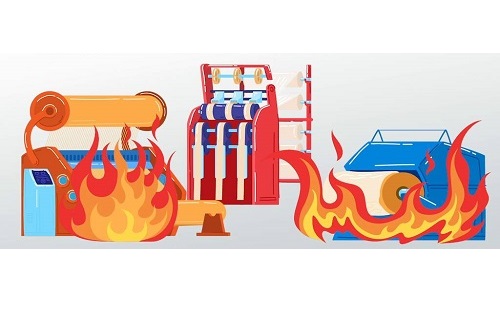Did you know that fire is one of the most common hazards faced by the textile industry? Since almost all materials and chemicals used to produce items made from natural or synthetic fibers are combustible, the risk of fire in the textile industry increases.
safety of the textile industry
Implementing effective fire prevention measures is essential to protect employees, assets and property. Let’s explore the significant fire threats in the textile industry and provide practical tips on how to prevent fires and ensure a safer work environment for everyone.
Before you begin to consider how to protect your workplace from fire, you must first understand the significant fire threats in the textile industry in order to ensure the safety of the textile industry. By being aware of these risks, you can play an active role in removing them from the workplace.
Combustible raw materials
In the textile industry, almost all materials used are flammable. These materials include cotton, flammable dyes, synthetic fibers and wool. As a result, proper storage and handling of these materials is very important to prevent fire. Keep these combustible materials in designated areas away from possible sources of ignition and ensure compliance with fire safety regulations when working with them.
creating a spark
Sparks can be generated from various sources such as friction during the manufacturing process or from electrical equipment and machinery in a factory. Therefore, every electrical tool used in a textile factory must be explosion-proof. These pieces of equipment, such as flameproof lamps and intrinsically safe junction boxes, have special sealing devices to maintain the integrity of the enclosure and minimize the risk of external ignition.
Explosion-proof equipment is designed to prevent the penetration of any flammable material into its housing.
machinery
Textile machinery, such as knitting machines and sewing machines, can increase the risk of fire if not properly maintained or electrical faults occur. Regular inspection and maintenance of textile machinery is essential to minimize the risk of electrical fires. Additionally, ensure that workers are trained in safe machine operation and emergency procedures.
Fire prevention in the textile industry

It is very important to implement effective fire prevention measures to prevent possible fire incidents. In the following, we discuss preventive measures to reduce the risk of fire in the textile industry.
Keep combustible dust away from machinery
Due to the presence of flammable raw materials in the factory, combustible dust such as lint and textile fibers can accumulate around the work environment and increase the risk of fire. Good housekeeping, including implementing adequate dust collection systems and regular cleaning of lint and dust, is essential to combat any dust accumulation. All work areas should also have proper ventilation to minimize the concentration of combustible dust in the environment and thus reduce the risk of explosion and fire.
Heat control of the working environment
Another important point of safety in the textile industry is heat and ambient temperature control. Excessive heat increases the risk of workplace fires. Beyond maintaining the proper temperature through proper ventilation, insulation, and the use of cooling systems, regularly inspect and maintain your equipment to prevent breakdowns and overheating. Any flammable material must be properly stored away from heat sources.
Flammable sources
All flammable sources must be kept away from the workplace. Electrical equipment and machinery can create a spark that can cause a fire. To minimize this risk, you can install intrinsically safe junction boxes (explosion-proof boxes) and explosion-proof switch socket outlets to provide an additional layer of protection and minimize the potential for ignition sources.
Storage of finished products
In the textile industry, proper storage and handling of raw materials and finished products is very important. These materials should be placed in designated places that are well ventilated, dry and away from combustible sources. In addition, explosion-proof lights should be installed to provide sufficient light to prevent accidents and minimize sources of ignition. Prepare storage areas for potential fire hazards (such as blocked exits or excessive clutter).
Use of anti-explosion equipment
One of the important points in establishing the safety of the textile industry and other industries is the use of anti-explosion equipment. These equipment prevent the penetration of flammable materials and increase safety.
Categories of anti-explosion equipment:
- Explosion-proof enclosures
- Explosion-proof lighting
- Anti-explosion gland
- Explosion-proof keys
- Explosion-proof ventilation
- Explosion-proof telecommunication systems
- Anti-explosion control systems
Proposal for the safety of the textile industry
Health and safety measures play an important role in all industries. Workers must be aware of the various occupational hazards common in their industry. At the same time, the management should take necessary measures to protect the workers from possible dangerous conditions.
Proposal for the safety of the textile industry:
- Health and safety measures play an important role in all industries. Workers must be aware of the various occupational hazards common in their industry. At the same time, the management should take necessary measures to protect the workers from possible dangerous conditions.
- The following suggestions have been made in order to improve health and safety conditions in textile units:
- Workers’ chairs and tables should be well aligned in terms of height so that workers do not suffer from musculoskeletal strain.
- The amount of light at the workplace should be appropriate to prevent eye fatigue.
- Timely maintenance and service of machines should be a priority, because this will reduce their noise level. In these periodic services, if a piece of machinery needs to be replaced, it must be replaced immediately.
- If it is not possible to control excess noise, workers should use earplugs, this work is effective to some extent in dealing with ambient noise.
- Workers who work with these noisy devices can be changed in shifts; This will ensure that they are never exposed to noise for a long time.
- The work environment should be well ventilated.
- In order for workers to be less exposed to dust, masks should be provided to them.
- Facilities such as trained medical personnel, first aid equipment and safety equipment such as fire extinguishers and fire alarms must be present in the workplace.
- In units that are exposed to hazardous chemicals, safety gloves should be provided to workers.
- Dust control equipment should be installed in the factory environment so that workers are less exposed to cotton dust.
- Workers must undergo medical examinations from time to time. If occupational health problems are observed among the workers, the management should put the necessary measures on its agenda.

